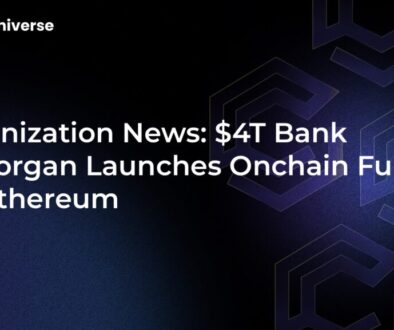5 Things to Know About Stripe’s Move to Build Its Own Blockchain

Stripe Enters the Crypto Arena with Its Own Blockchain, Tempo
The whispers are true. Fintech titan Stripe, a name synonymous with modern online payments, is making a monumental leap from crypto integration to crypto creation. In a move that sent shockwaves through the tech and finance worlds, news broke that Stripe is quietly developing its own Layer-1 blockchain called Tempo, in partnership with crypto venture capital giant Paradigm.
This isn’t just another company adding crypto payment options. Stripe is building the fundamental infrastructure, the digital railroad, for a new era of finance. The project, previously developed in stealth by a small, dedicated team, was revealed through a job posting seeking talent for a “high-performance, payments-focused blockchain.”
This development is more than just an update; it’s a strategic masterstroke that has been years in the making. To understand the full scope of this seismic shift, here are the <5 Things to Know About Stripe’s Move to Build Its Own Blockchain>.
1. What Exactly is Tempo?
Tempo is not just another blockchain; it’s a Layer-1 (L1) network built from the ground up. Think of a Layer-1 as the foundational layer of a blockchain ecosystem, like Bitcoin or Ethereum. It’s the base upon which everything else is built, responsible for processing and validating all transactions.
Stripe is designing Tempo with two core principles in mind:
- Payments-Focused: Unlike general-purpose blockchains, Tempo is being optimized specifically for high-speed, low-cost payment transactions. This focus could allow it to challenge legacy payment systems like SWIFT and even modern alternatives like FedNow.
- Ethereum-Compatible: Tempo will be compatible with Ethereum’s Solidity toolchains. This is a brilliant move for adoption, as it means millions of developers already familiar with building on Ethereum can start working with Tempo without learning a new programming language or set of tools.
2. It’s the Final Piece of a Strategic Crypto Puzzle
Stripe’s move to build Tempo isn’t a sudden pivot; it’s the logical conclusion of a multi-year strategy to own the entire crypto payment stack. The company has been methodically acquiring key pieces of the puzzle:
- The On/Off-Ramp (Bridge): Stripe acquired stablecoin platform Bridge, giving it the crucial infrastructure to move money between traditional fiat currency and digital stablecoins seamlessly.
- The Wallet (Privy): The more recent acquisition of wallet developer Privy provides the user-facing component, allowing for the creation and management of embedded crypto wallets directly within apps and websites.
- The Rails (Tempo): Tempo is the final, and most critical, piece. It’s the underlying blockchain network—the payment rails—that connects everything.
By controlling the wallet, the on/off-ramps, and now the blockchain itself, Stripe is positioning itself to offer a fully integrated, end-to-end payment solution with unparalleled efficiency and control.
3. The Goal is Full-Stack Control and Disruption
Why build when you can partner? For Stripe, the answer is control. By creating its own blockchain, Stripe is no longer reliant on third-party networks. This vertical integration allows the company to:
- Optimize Speed and Cost: Stripe can fine-tune every aspect of the network to prioritize fast settlement times and drastically lower transaction fees for its merchants and users.
- Enhance Security and Reliability: Owning the infrastructure means Stripe can set its own security standards and ensure network uptime, a critical factor for a global payments processor.
- Drive Innovation: A custom blockchain allows Stripe to build unique features and integrations tailored to its massive network of merchants, from Fortune 500 companies to small online stores.
This level of control positions Tempo as a direct challenger to the established order of cross-border payments, promising a faster, cheaper, and more efficient alternative.
4. This Could Be a Tipping Point for Mainstream Crypto Adoption
The significance of a $65 billion payments powerhouse like Stripe building its own L1 cannot be overstated. This is arguably one of the most important validation signals for the entire blockchain industry.
Most new blockchains struggle with the chicken-and-egg problem: they need users to attract developers, and developers to attract users. Tempo could sidestep this entirely. With Stripe’s vast global merchant network, Tempo could have more real-world adoption and transaction volume from day one than most chains achieve in their entire lifecycle.
This move blurs the lines between traditional fintech and decentralized finance (DeFi), showing that the future of finance is not one or the other, but a powerful hybrid of both.
5. Key Questions Remain Unanswered
Because the news emerged from a job listing rather than an official company announcement, many crucial details are still under wraps. The crypto community is buzzing with speculation, but for now, we are left with several big questions:
- Will There Be a Native Token? A public blockchain often has a native token (like ETH for Ethereum) for paying gas fees and for governance. Will Stripe launch a $TEMPO or $STRIP token, and if so, will it be available to the public?
- What is the Governance Model? Will Tempo be a permissioned network controlled by Stripe, or a more decentralized, permissionless blockchain open to all? The answer will determine its level of censorship resistance and openness.
- What is the Official Launch Timeline? The project is clearly in development, but a public roadmap or launch date has not been announced.
Conclusion: Stripe is Not Adopting Crypto; It’s Becoming Crypto
Stripe’s development of the Tempo blockchain is a clear statement of intent. The company is transitioning from a user of crypto technologies to a foundational builder of the new financial internet. By combining its global distribution with a custom-built payment blockchain, Stripe is poised to accelerate the mainstream adoption of stablecoins and on-chain payments in a way few others can.
While we await more official details, one thing is certain: the entire world should be watching Stripe not just as a fintech innovator, but as a future giant of the crypto infrastructure landscape.


